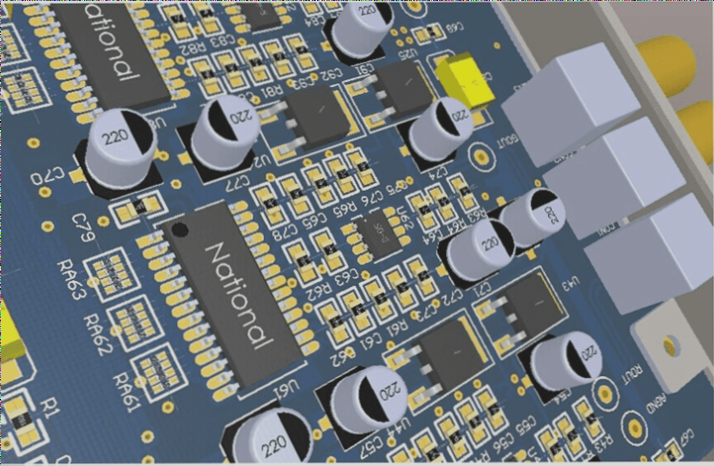With the rapid progress of the electronics industry, the application of high-frequency circuit boards has become a necessity in fields like air transportation and satellite systems.
So, what are the basic requirements for the material properties of high-frequency circuit board production when selecting PCB substrates?
(1) Dielectric constant (Dk): Dk needs to be small and stable. Under normal circumstances, the smaller the Dk, the faster the signal transmission speed. Signal transmission speed is inversely proportional to the square root of the dielectric constant of the substrate. A higher Dk can lead to signal transmission delay.
(2) Dielectric loss: The smaller the Dk, the better the signal transmission quality and the lower the dielectric loss, resulting in reduced signal loss.
(3) The thermal expansion coefficient of copper foil should be as consistent as possible, with low water absorption. Other essential properties include heat resistance, chemical resistance, impact strength, and peel strength.
Typically, high-frequency boards are defined as operating above 1GHz. Most high-frequency circuit board substrates currently in production are fluorine-based dielectric substrates, such as Teflon, which are predominantly used above 5GHz. FR4 substrates are used in the frequency range of 1GHz to 10GHz. For optimal frequency characteristics, Teflon is the preferred choice. If product frequencies exceed 10GHz, Teflon is often the only viable option. However, not all high-frequency PCBs must use Teflon; the choice depends on specific product requirements dictated by customer needs.

There are five specific characteristics of high-frequency circuit boards:
(1) Gain: High-frequency circuits differ from low-frequency power supply circuits in that they focus on voltage gain and output power. In resonant differential amplification circuits, this refers to the resonant frequency ( f_0 ). For optical fiber broadband differential amplification circuits, it pertains to a specific frequency range.
(2) Bandwidth: Low-frequency power supply circuit boards exhibit good characteristics here. In resonant differential amplifier circuits, it refers to the bandwidth between the frequencies where the normalized vibration amplitude drops to 0.707 of ( f_0 ). For optical fiber broadband amplification circuits, it relates to a specific frequency range.
(3) Selectivity: This characteristic is crucial for resonant amplification circuits. It defines a circuit’s ability to select useful signals and suppress unwanted signals. Selectivity is typically evaluated using the circuit’s resonance characteristic curve, including metrics such as the quality factor and rejection ratio.
(4) Noise Figure: During operation, amplification circuits experience irregular fluctuations due to various factors. Internal circuit noise impacts signal quality, typically described as the ratio of signal power (PS) to noise power (PN), often denoted as SNR (Signal-to-Noise Ratio). The noise figure quantifies the contrast between input and output signal noise.
(5) Stability: The stability of a high-frequency circuit board refers to its ability to maintain consistent performance despite changes in operating conditions. Variations in environmental temperature or power supply voltage can disrupt DC operation and alter circuit component parameters. This instability can manifest as changes in amplification circuit gain, shifts in center frequency, or sudden alterations in the resonance curve, potentially rendering the circuit inoperative.
So, what are the basic requirements for the material properties of high-frequency circuit board production when selecting PCB substrates?
(1) Dielectric constant (Dk): Dk needs to be small and stable. Under normal circumstances, the smaller the Dk, the faster the signal transmission speed. Signal transmission speed is inversely proportional to the square root of the dielectric constant of the substrate. A higher Dk can lead to signal transmission delay.
(2) Dielectric loss: The smaller the Dk, the better the signal transmission quality and the lower the dielectric loss, resulting in reduced signal loss.
(3) The thermal expansion coefficient of copper foil should be as consistent as possible, with low water absorption. Other essential properties include heat resistance, chemical resistance, impact strength, and peel strength.
Typically, high-frequency boards are defined as operating above 1GHz. Most high-frequency circuit board substrates currently in production are fluorine-based dielectric substrates, such as Teflon, which are predominantly used above 5GHz. FR4 substrates are used in the frequency range of 1GHz to 10GHz. For optimal frequency characteristics, Teflon is the preferred choice. If product frequencies exceed 10GHz, Teflon is often the only viable option. However, not all high-frequency PCBs must use Teflon; the choice depends on specific product requirements dictated by customer needs.

There are five specific characteristics of high-frequency circuit boards:
(1) Gain: High-frequency circuits differ from low-frequency power supply circuits in that they focus on voltage gain and output power. In resonant differential amplification circuits, this refers to the resonant frequency ( f_0 ). For optical fiber broadband differential amplification circuits, it pertains to a specific frequency range.
(2) Bandwidth: Low-frequency power supply circuit boards exhibit good characteristics here. In resonant differential amplifier circuits, it refers to the bandwidth between the frequencies where the normalized vibration amplitude drops to 0.707 of ( f_0 ). For optical fiber broadband amplification circuits, it relates to a specific frequency range.
(3) Selectivity: This characteristic is crucial for resonant amplification circuits. It defines a circuit’s ability to select useful signals and suppress unwanted signals. Selectivity is typically evaluated using the circuit’s resonance characteristic curve, including metrics such as the quality factor and rejection ratio.
(4) Noise Figure: During operation, amplification circuits experience irregular fluctuations due to various factors. Internal circuit noise impacts signal quality, typically described as the ratio of signal power (PS) to noise power (PN), often denoted as SNR (Signal-to-Noise Ratio). The noise figure quantifies the contrast between input and output signal noise.
(5) Stability: The stability of a high-frequency circuit board refers to its ability to maintain consistent performance despite changes in operating conditions. Variations in environmental temperature or power supply voltage can disrupt DC operation and alter circuit component parameters. This instability can manifest as changes in amplification circuit gain, shifts in center frequency, or sudden alterations in the resonance curve, potentially rendering the circuit inoperative.



